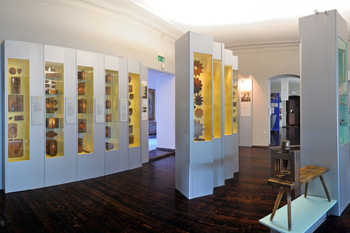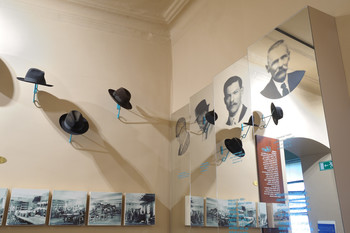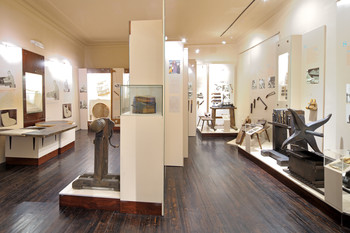Ethnological Collections
The first part of the Ethnology Collections is a smoke kitchen, which contains various items used for cooking and baking back in the day. There are also a number of illuminants from the pre-electrification period.
The Vernacular Architecture Collection consist of a farmhouse with a smoke kitchen, a rural mansion, a burgher's house and a roofed double hayrack from the Tavčar Homestead in Visoko, as well as some items made by blacksmiths.
Smoke Kitchen, Lighting
The first part of the Ethnology Collections is a smoke kitchen, which contains various items used for cooking and baking back in the day. There are also a number of illuminants from the pre-electrification period.
Vernacular Architecture Collection
The Vernacular Architecture Collection consist of a farmhouse with a smoke kitchen, a rural mansion, a burgher's house and a roofed double hayrack from the Tavčar Homestead in Visoko, as well as some items made by blacksmiths.
Crop Farming, Animal Husbandry, Food, Transport
In this room, visitors can learn about the history and objects related to beekeeping, crop farming, animal husbandry, food, traffic and transport from the 19th century and the early 20th century.
Skilled Trade Collections
The Skilled Trade Collections present all the important skilled trades practiced in Škofja Loka and the surrounding rural area from the Middle Ages onwards. Various products, processes, tools and materials used are also exhibited.
Sieve Making, Lacemaking
From the 16th to the mid-20th centuries, the sieve-maker's trade was practiced by the poorer part of the local population in the area from Kranj to Škofja Loka, with the hub of sieve making in the villages of Stražišče and Bitnje. Sieves were made from horsehair and were exported to several European countries.
Bobbin lace came to the area of Škofja Loka in the mid-19th century from the mining town of Idrija, where the lacemaking craft was first mentioned in 1696. In the early 20th century, Škofja Loka boasted as many as three bobbin-lacemaking schools. Bobbin lacemaking in Slovenia has been inscribed on the UNESCO Representative List of the Intangible Cultural Heritage of Humanity.
Hat Making, Comb Making
In collaboration with hatters from the town of Kranj, hat makers from Škofja Loka founded their guild in 1633. They used sheep's wool and rabbit pelts to make men's and children's hats, as well as boots and slippers. The Šešir Hat Factory was established in Škofja Loka in 1921.
The earliest mention of the comb-maker's trade in Škofja Loka goes back to 1752. Comb makers used cattle and wether horns to make various combs, as well as tablespoons, bone knife and fork handles, walking sticks, etc.
Linen Making and Dyeing
In the area of Škofja Loka, the culture of flax growing and processing dates back to the 12th century. In the 18th century, Škofja Loka became the linen-making centre of the Upper Carniola (Gorenjska) region and was also important on a European scale.
Linen making resulted in the development of linen dyeing, whose earliest mention as a guild trade goes back to 1673. Initially, linen was only dyed, and from the early 19th century onwards, various patterns were also printed on it.
Little Breads and Artificial Flowers
The so-called little breads are a local honey-bread variety made in two ways: the dough is either imprinted into special carved wooden moulds or shaped and decorated by hand (the Dražgoše honey breads). The honey-bread making skills were passed on to the local people from the Ursuline monastery in Škofja Loka.
Artificial flowers made of wax, cloth and paper were handcrafted by the Poor Clares of Škofja Loka as early as the mid-18th century – they used them to adorn various devotional statuettes. Later, making flowers from crêpe paper was an important cottage industry for some local women. People used them to decorate their living quarters, wayside shrines, columns, church altars and also as accessories on special occasions, such as weddings, enlistment, funerals etc.







